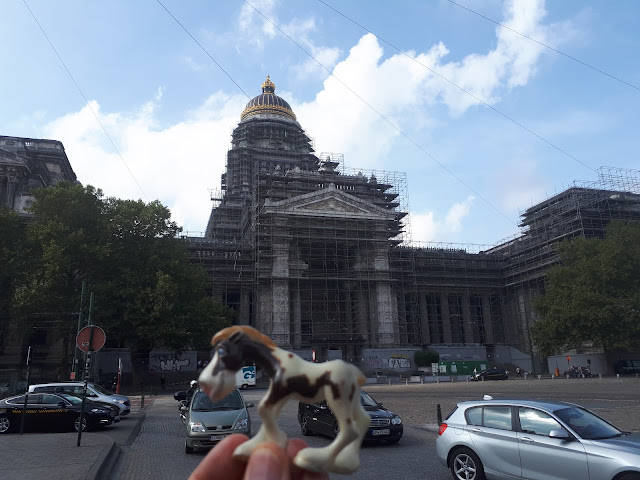Although Grand Place is the most marvelous place in Brussels, there are also other interesting sites. When you look at the UNESCO World Heritage list you will find there also for example two hotels designed by Victor Horta. The first one is located in the small Rue Paul-Emile Jansonstraat, visible over the crossing.
It is called Hotel Tassel and is considered as the first true Art Nouveau building, because of its highly innovative plan and its groundbreaking use of materials and decoration.
This is the building in the middle.
Unfortunately, although it is called a hotel, it is currently a private office so visitors are not allowed. The same applies to the second building - The Solvay House.
The house was commissioned by Armand Solvay, the son of the wealthy Belgian chemist and industrialist Ernest Solvay. For this wealthy patron Horta could spend a fortune on precious materials and expensive details. Horta designed every single detail; furniture, carpets, light fittings, tableware and even the door bell. He used expensive materials such as marble, onyx, bronze, tropic woods etc. For the decoration of the staircase Horta cooperated with the Belgian pointillist painter Théo van Rysselberghe.
It was built between 1866 and 1883 in the eclectic style by the celebrated architect Joseph Poelaert. It is reputed to be the largest building constructed in the 19th century. Unesco is considering making it one of the next Belgian world heritage sites.
Just next to it you can admire the glory of Belgian infrantry for their effort in both World Wars ...
... and Anglo-Belgian War Memorial commemorating the support given by the Belgian People to British prisoners of war during the First World War.
But obviously there are also horses in Brussles. Please admire my beautiful ancestor here. He is standing at the center of Place Royale. The strange gentleman riding on his back is Godfrey of Bouillon, the leader of the first crusade in 1096.
Just left from their monument you can find Saint Jacques-sur-Coudenberg church. But its most important part of are the steps. On theeese steps, on July 21, 1831, Prince Leopold of Saxe-Coburg-Gotha took the oath that made him H.M. Leopold I, the first King of the Belgians
Between Palace of Justice and Place Royale there are a few other interestig places. The first one is the first international post office in Brussels, open in 1516 and run by The Princely House of Thurn and Taxis within Holy Roman Empire until 1867, so even after Empire colapsed in 1806.
And here is the post entrance.
The modern post box is still here!
But the most beautiful part is a small park of The Kleine Zavel (Place du Petit Sablon).
In its central point you can take the rest from citi rush next to the Count Egmont and Count Hoorn. They were both key figures in the 16 th-century Dutch revolt against Spanish rule that resulted in the Eighty Years War and an independent Dutch Republic.
Another attraction of the Kleine Zavel park is the fence – each statue, pillar and section of wrought ironwork is unique. These 48 life-sized statues represent the traditional trades and guilds of Brussels. The various guilds and trades can be identified by their typical instruments or symbols. For example, the roofers with a ladder as visible on the picture.
Just next to the park you can admire Church of Our Blessed Lady of the Sablon, which was patronised by the nobility and wealthy citizens of Brussels.
Typical for Brabanitine was use of light-coloured sandstone or limestone, which allowed rich detailing but is erosion-prone.
It is standing on the location of the chapel of the Crossbow Guild, which is very important for Brussels. According to a legend, a local devout woman named Beatrijs Soetkens had a vision in which the Virgin Mary instructed her to steal the miraculous statue of "Our Lady on the little stick" in Antwerp, bring it to Brussels and place it here. The woman stole the statue and, through a series of miraculous events, was able to bring it to Brussels by boat, in 1348.
The Guild promised to hold an annual procession, called an 'Ommegang', in which the statue was carried through Brussels. It was continuosly run from 1348 to 1785. In 1930, on the occasion of the 100th anniversary of Belgium, some history enthusiasts supported efforts to commemorate once again this demonstration, in the form of a historical procession. Given the success of this performance, it was decided to repeat it in subsequent years.
Great! That is the end of Brussels visiting. Time for ice cream!
























No comments:
Post a Comment